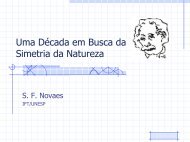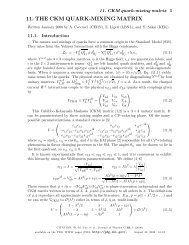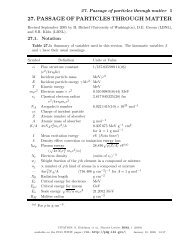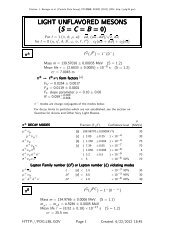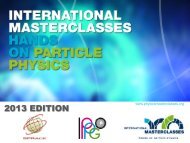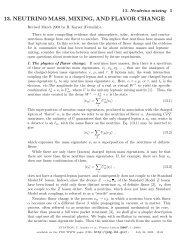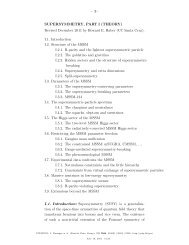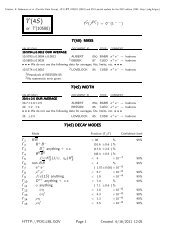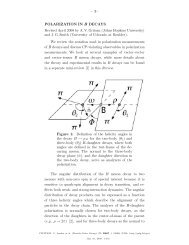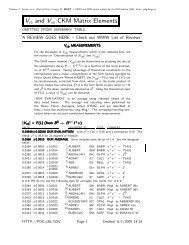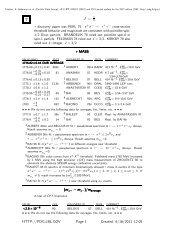Number of Light Neutrino Types - Particle Data Group
Number of Light Neutrino Types - Particle Data Group
Number of Light Neutrino Types - Particle Data Group
You also want an ePaper? Increase the reach of your titles
YUMPU automatically turns print PDFs into web optimized ePapers that Google loves.
– 1–<br />
THE NUMBER OF LIGHT NEUTRINO TYPES<br />
FROM COLLIDER EXPERIMENTS<br />
Revised March 2008 by D. Karlen (University <strong>of</strong> Victoria and<br />
TRIUMF).<br />
The most precise measurements <strong>of</strong> the number <strong>of</strong> light<br />
neutrino types, N ν , come from studies <strong>of</strong> Z production in e + e −<br />
collisions. The invisible partial width, Γ inv , is determined by<br />
subtracting the measured visible partial widths, corresponding<br />
to Z decays into quarks and charged leptons, from the total Z<br />
width. The invisible width is assumed to be due to N ν light<br />
neutrino species each contributing the neutrino partial width<br />
Γ ν as given by the Standard Model. In order to reduce the<br />
model dependence, the Standard Model value for the ratio <strong>of</strong><br />
the neutrino to charged leptonic partial widths, (Γ ν /Γ l ) SM =<br />
1.991±0.001, is used instead <strong>of</strong> (Γ ν ) SM to determine the number<br />
<strong>of</strong> light neutrino types:<br />
N ν = Γ inv<br />
Γ l<br />
(<br />
Γl<br />
Γ ν<br />
)SM<br />
. (1)<br />
The combined result from the four LEP experiments is N ν =<br />
2.984 ± 0.008 [1].<br />
In the past, when only small samples <strong>of</strong> Z decays had been<br />
recorded by the LEP experiments and by the Mark II at SLC,<br />
the uncertainty in N ν was reduced by using Standard Model<br />
fits to the measured hadronic cross sections at several center<strong>of</strong>-mass<br />
energies near the Z resonance. Since this method is<br />
much more dependent on the Standard Model, the approach<br />
described above is favored.<br />
Before the advent <strong>of</strong> the SLC and LEP, limits on the<br />
number <strong>of</strong> neutrino generations were placed by experiments at<br />
lower-energy e + e − colliders by measuring the cross section <strong>of</strong><br />
the process e + e − → ννγ. The ASP, CELLO, MAC, MARK J,<br />
and VENUS experiments observed a total <strong>of</strong> 3.9 events above<br />
background [2], leading to a 95% CL limit <strong>of</strong> N ν < 4.8.<br />
This process has a much larger cross section at center-<strong>of</strong>-mass<br />
energies near the Z mass and has been measured at LEP by<br />
the ALEPH, DELPHI, L3, and OPAL experiments [3]. These<br />
experiments have observed several thousand such events, and<br />
CITATION: J. Beringer et al. (<strong>Particle</strong> <strong>Data</strong> <strong>Group</strong>), PR D86, 010001 (2012) (URL: http://pdg.lbl.gov)<br />
June 18, 2012 15:23
– 2–<br />
the combined result is N ν = 3.00 ± 0.08. The same process has<br />
also been measured by the LEP experiments at much higher<br />
center-<strong>of</strong>-mass energies, between 130 and 208 GeV, in searches<br />
for new physics [4]. Combined with the lower energy data, the<br />
result is N ν = 2.92 ± 0.05.<br />
Experiments at pp colliders also placed limits on N ν by<br />
determining the total Z width from the observed ratio <strong>of</strong> W ± →<br />
l ± ν to Z → l + l − events [5]. This involved a calculation that<br />
assumed Standard Model values for the total W width and the<br />
ratio <strong>of</strong> W and Z leptonic partial widths, and used an estimate<br />
<strong>of</strong> the ratio <strong>of</strong> Z to W production cross sections. Now that the<br />
Z width is very precisely known from the LEP experiments, the<br />
approach is now one <strong>of</strong> those used to determine the W width.<br />
References<br />
1. ALEPH, DELPHI, L3, OPAL, and SLD Collaborations, and<br />
LEP Electroweak Working <strong>Group</strong>, and SLD Electroweak<br />
<strong>Group</strong>, and SLD Heavy Flavour <strong>Group</strong>, Phys. Reports<br />
427, 257 (2006).<br />
2. VENUS: K. Abe et al., Phys. Lett. B232, 431 (1989);<br />
ASP: C. Hearty et al., Phys. Rev. D39, 3207 (1989);<br />
CELLO: H.J. Behrend et al., Phys. Lett. B215, 186 (1988);<br />
MAC: W.T. Ford et al., Phys. Rev. D33, 3472 (1986);<br />
MARK J: H. Wu, Ph.D. Thesis, Univ. Hamburg (1986).<br />
3. L3: M. Acciarri et al., Phys. Lett. B431, 199 (1998);<br />
DELPHI: P. Abreu et al., Z. Phys. C74, 577 (1997);<br />
OPAL: R. Akers et al., Z. Phys. C65, 47 (1995);<br />
ALEPH: D. Buskulic et al., Phys. Lett. B313, 520 (1993).<br />
4. DELPHI: J. Abdallah et al., Eur. Phys. J. C38, 395 (2005);<br />
L3: P. Achard et al., Phys. Lett. B587, 16 (2004);<br />
ALEPH: A. Heister et al., Eur. Phys. J. C28, 1 (2003);<br />
OPAL: G. Abbiendi et al., Eur. Phys. J. C18, 253 (2000).<br />
5. UA1: C. Albajar et al., Phys. Lett. B198, 271 (1987);<br />
UA2: R. Ansari et al., Phys. Lett. B186, 440 (1987).<br />
June 18, 2012 15:23



